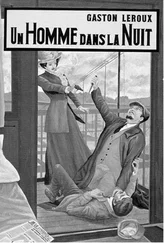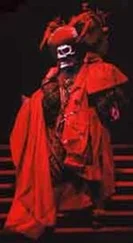This was the hour.
Opposite the lofty cathedral, reddened by the setting sun, on the stone balcony built above the porch of a rich Gothic house, which formed the angle of the square and the Rue du Parvis, several young girls were laughing and chatting with every sort of grace and mirth. From the length of the veil which fell from their pointed coif, twined with pearls, to their heels, from the fineness of the embroidered chemisette which covered their shoulders and allowed a glimpse, according to the pleasing custom of the time, of the swell of their fair virgin bosoms, from the opulence of their under-petticoats still more precious than their overdress (marvellous refinement), from the gauze, the silk, the velvet, with which all this was composed, and, above all, from the whiteness of their hands, which certified to their leisure and idleness, it was easy to divine they were noble and wealthy heiresses. They were, in fact, Damoiselle Fleur-de-Lys de Gondelaurier and her companions, Diane de Christeuil, Amelotte de Montmichel, Colombe de Gaillefontaine, and the little de Champchevrier maiden; all damsels of good birth, assembled at that moment at the house of the dame widow de Gondelaurier, on account of Monseigneur de Beaujeu and Madame his wife, who were to come to Paris in the month of April, there to choose maids of honor for the Dauphiness Marguerite, who was to be received in Picardy from the hands of the Flemings. Now, all the squires for twenty leagues around were intriguing for this favor for their daughters, and a goodly number of the latter had been already brought or sent to Paris. These four maidens had been confided to the discreet and venerable charge of Madame Aloise de Gondelaurier, widow of a former commander of the king’s cross-bowmen, who had retired with her only daughter to her house in the Place du Parvis, Notre-Dame, in Paris.
The balcony on which these young girls stood opened from a chamber richly tapestried in fawn-colored Flanders leather, stamped with golden foliage. The beams, which cut the ceiling in parallel lines, diverted the eye with a thousand eccentric painted and gilded carvings. Splendid enamels gleamed here and there on carved chests; a boar’s head in faience crowned a magnificent dresser, whose two shelves announced that the mistress of the house was the wife or widow of a knight banneret. At the end of the room, by the side of a lofty chimney blazoned with arms from top to bottom, in a rich red velvet arm-chair, sat Dame de Gondelaurier, whose five and fifty years were written upon her garments no less distinctly than upon her face.
Beside her stood a young man of imposing mien, although partaking somewhat of vanity and bravado—one of those handsome fellows whom all women agree to admire, although grave men learned in physiognomy shrug their shoulders at them. This young man wore the garb of a captain of the king’s unattached archers, which bears far too much resemblance to the costume of Jupiter, which the reader has already been enabled to admire in the first book of this history, for us to inflict upon him a second description.
The damoiselles were seated, a part in the chamber, a part in the balcony, some on square cushions of Utrecht velvet with golden corners, others on stools of oak carved in flowers and figures. Each of them held on her knee a section of a great needlework tapestry, on which they were working in company, while one end of it lay upon the rush mat which covered the floor.
They were chatting together in that whispering tone and with the half-stifled laughs peculiar to an assembly of young girls in whose midst there is a young man. The young man whose presence served to set in play all these feminine self-conceits, appeared to pay very little heed to the matter, and, while these pretty damsels were vying with one another to attract his attention, he seemed to be chiefly absorbed in polishing the buckle of his sword belt with his doeskin glove. From time to time, the old lady addressed him in a very low tone, and he replied as well as he was able, with a sort of awkward and constrained politeness.
From the smiles and significant gestures of Dame Aloise, from the glances which she threw towards her daughter, Fleur-de-Lys, as she spoke low to the captain, it was easy to see that there was here a question of some betrothal concluded, some marriage near at hand no doubt, between the young man and Fleur-de-Lys. From the embarrassed coldness of the officer, it was easy to see that on his side, at least, love had no longer any part in the matter. His whole air was expressive of constraint and weariness, which our lieutenants of the garrison would to-day translate admirably as, “What a beastly bore!”
The poor dame, very much infatuated with her daughter, like any other silly mother, did not perceive the officer’s lack of enthusiasm, and strove in low tones to call his attention to the infinite grace with which Fleur-de-Lys used her needle or wound her skein.
“Come, little cousin,” she said to him, plucking him by the sleeve, in order to speak in his ear, “Look at her, do! see her stoop.”
“Yes, truly,” replied the young man, and fell back into his glacial and absent-minded silence.
A moment later, he was obliged to bend down again, and Dame Aloise said to him,—
“Have you ever beheld a more gay and charming face than that of your betrothed? Can one be more white and blonde? are not her hands perfect? and that neck—does it not assume all the curves of the swan in ravishing fashion? How I envy you at times! and how happy you are to be a man, naughty libertine that you are! Is not my Fleur-de-Lys adorably beautiful, and are you not desperately in love with her?”
“Of course,” he replied, still thinking of something else.
“But do say something,” said Madame Aloise, suddenly giving his shoulder a push; “you have grown very timid.”
We can assure our readers that timidity was neither the captain’s virtue nor his defect. But he made an effort to do what was demanded of him.
“Fair cousin,” he said, approaching Fleur-de-Lys, “what is the subject of this tapestry work which you are fashioning?” “Fair cousin,” responded Fleur-de-Lys, in an offended tone, “I have already told you three times. ‘Tis the grotto of Neptune.”
It was evident that Fleur-de-Lys saw much more clearly than her mother through the captain’s cold and absent-minded manner. He felt the necessity of making some conversation.
“And for whom is this Neptunerie destined?”
“For the Abbey of Saint-Antoine des Champs,” answered Fleur-de-Lys, without raising her eyes.
The captain took up a corner of the tapestry.
“Who, my fair cousin, is this big gendarme, who is puffing out his cheeks to their full extent and blowing a trumpet?”
“‘Tis Triton,” she replied.
There was a rather pettish intonation in Fleur-de-Lys’s—laconic words. The young man understood that it was indispensable that he should whisper something in her ear, a commonplace, a gallant compliment, no matter what. Accordingly he bent down, but he could find nothing in his imagination more tender and personal than this,—
“Why does your mother always wear that surcoat with armorial designs, like our grandmothers of the time of Charles VII.? Tell her, fair cousin, that ‘tis no longer the fashion, and that the hinge (gond) and the laurel (laurier) embroidered on her robe give her the air of a walking mantlepiece. In truth, people no longer sit thus on their banners, I assure you.”
Fleur-de-Lys raised her beautiful eyes, full of reproach, “Is that all of which you can assure me?” she said, in a low voice.
In the meantime, Dame Aloise, delighted to see them thus bending towards each other and whispering, said as she toyed with the clasps of her prayer-book,—
Читать дальше









